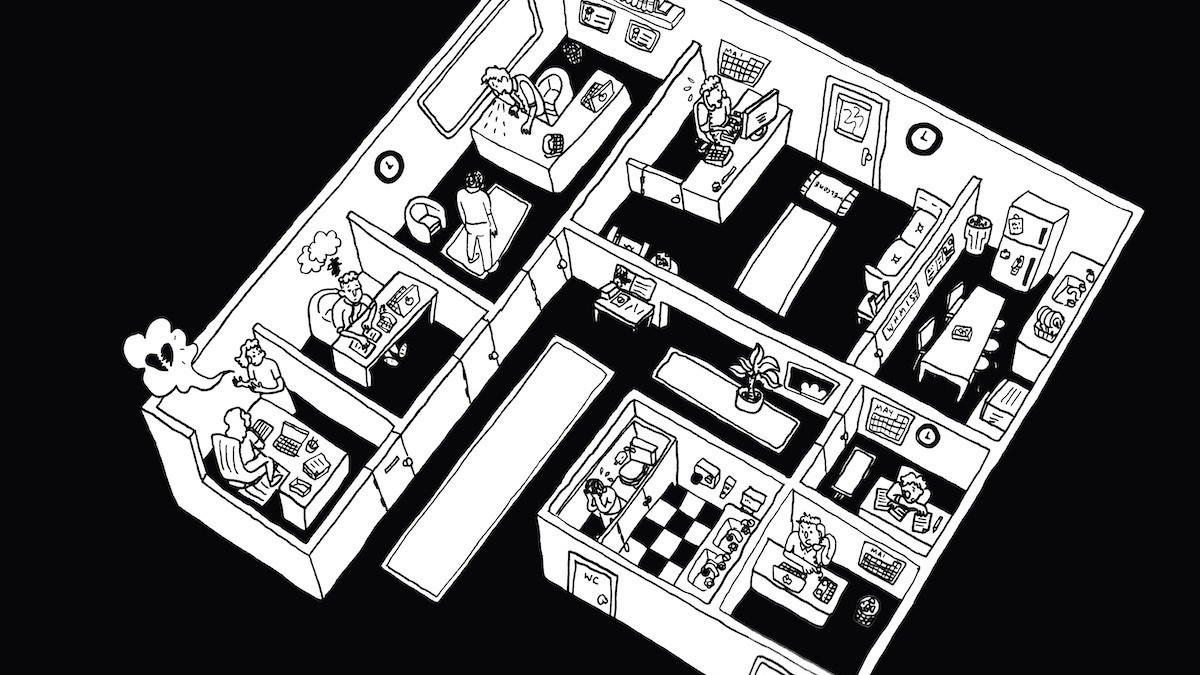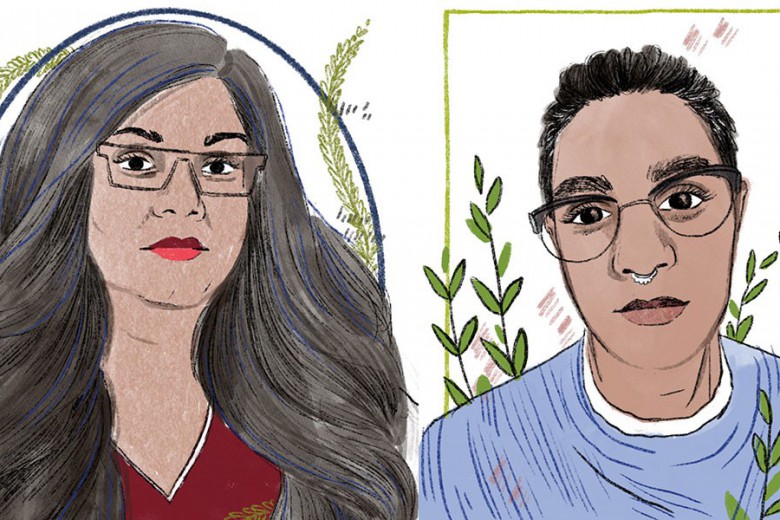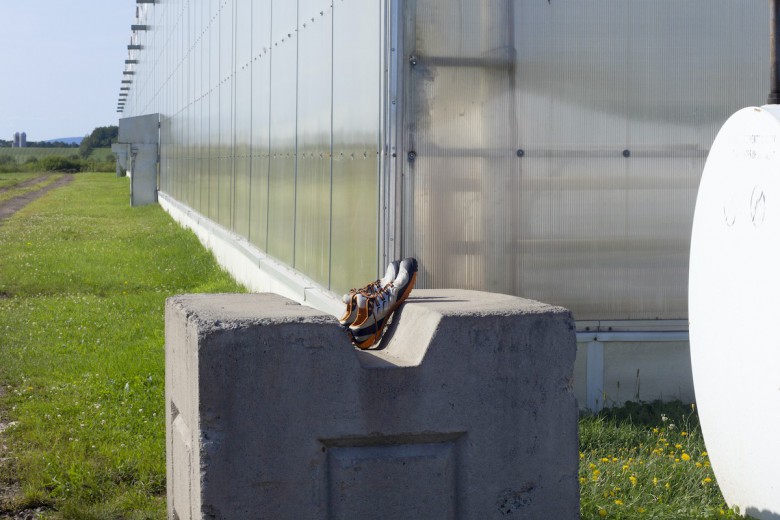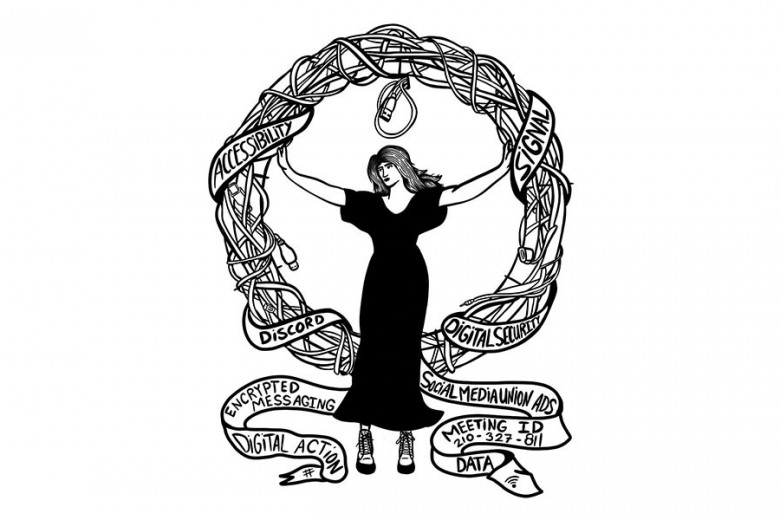“People don’t leave jobs,” Sammy told me. “They leave managers.”
Sammy (whose name has been changed) is a former employee of a Canadian nonprofit organization called the Canadian Centre for Gender and Sexual Diversity. Our phone conversation was one of five interviews I held with four people who worked at the CCGSD between 2013 and 2017, all of which centred around one big question: how exactly did things go so wrong?
The CCGSD is one of Canada’s few national LGBTQ organizations. Working toward what its website calls "a shared vision of a discrimination-free gender and sexually diverse world,” the nonprofit runs free anti-bullying workshops in schools, GSA conferences for kids and training forums for teachers, and legislative campaigns for intersex rights and against conversion therapy, to name a few. The CCGSD is a big name in the Canadian nonprofit world: it works with Pride festivals across the country; is frequently contacted for statements and perspectives by mainstream media; and is looked to by schools and institutions as a key source of insight into queer issues and experiences. At the time of my writing, its website lists 13 staff members, though the organization also boasts a strong volunteer workforce for large-scale events. They do valuable, important work, and many community members recognize them as a lifeline for queer youth.
Originally called “Jer’s Vision” (after Jeremy Dias himself), the CCGSD was launched from seed funds earned through an Ontario Human Rights Commission settlement that Dias won against his homophobic school and school board in 2005.
The organization’s main claim to fame is the International Day of Pink, on which students and educators around the world are encouraged to wear pink in solidarity with kids targeted for homophobic bullying. As of 2020, the CCGSD is no longer officially associated with the Day of Pink. (The Day of Pink website is devoid of any clarifying information on who currently runs that program, which calls itself “a registered charity run by volunteers working in communities across Canada”).
The CCGSD was the pet project of Jeremy Dias, who would later become its executive director. Even though Dias no longer works for the CCGSD in an official capacity (their website states that he stepped down last year to pursue an MBA), his influence is unmistakeable; Dias is all over the organization’s website, and his personal story is, in many ways, also the story of the organization. Originally called “Jer’s Vision” (after Jeremy Dias himself), the CCGSD was launched from seed funds earned through an Ontario Human Rights Commission settlement that Dias won against his homophobic school and school board in 2005. The victory propelled Dias – then 21 years old – to the forefront of the Canadian LGBTQ nonprofit world for over a decade. He was the executive director of the CCGSD for its entire lifetime, until he stepped down last year.
But Dias' role in the organization was never so cut-and-dry. In function, if not always in title, he was also the CCGSD's entire HR department, head of payroll, the treasurer for its projects, and everyone's direct manager and immediate supervisor. For a long time, as well, Dias was effectively the organization's sole voting member, a technical detail that gave him total authority over the CCGSD, beyond even the reach of its volunteer board of directors. As “Founder,” the organization's bylaws enshrined Dias as “the sole Member of the Corporation unless he, in his absolute discretion, approves the admission of additional Members.”
These bylaws remained in effect until 2018. An statement shared to the CCGSD website on November 24, 2018, written by board president Calla Barnett, announced changes to the organization structure to amend this earlier arrangement. “There were no formal policies implemented and the bylaw allowed for power to be concentrated with a single individual,” reads the statement, which also included the vague acknowledgment that "Office culture was not conducive to the social justice values we hold as an organization.” Last month, the CCGSD emailed out another statement, offering an apology to “Black people, Indigenous people, and People of Colour [who] have been caused harm by the CCGSD,” and noting recent policy changes that allow staff members to weigh in on the organization’s strategy and structure.
For a long time, as well, Dias was effectively the organization's sole voting member, a technical detail that gave him total authority over the CCGSD, beyond even the reach of its volunteer board of directors.
In August 2016, Dias was suspended by the board of directors and stripped of financial power over the organization. For roughly two months, the board conducted a full investigation with the help of external lawyers, related to allegations of serious professional misconduct and demands for organizational restructuring. Soon after, as part of the restructuring process, Dias returned. Several board members quit; the remaining two were let go by Dias, who had the authority as the organization’s sole legally-recognized member to appoint and remove people from the board. Sammy described the ensuing months as a “witch hunt” where earlier employees were pressured to leave the organization. Dias held on to the executive director role until June 2019.
Crossing boundaries
Nonprofit organizations are complex beasts, driven by a combination of undervalued labour and visionary principle. The CCGSD was no exception. Everyone I talked to spoke highly of the organization’s mission and impact, and believed in the value of working alongside other queer people. Nevertheless, each of them said that it was an unpredictable and unhealthy place to work. According to four former employees who agreed to speak on the record – Sammy, Jamie, Maya, and Baz– it was hard to know what to expect from one day to the next. For their safety and privacy, Sammy, Jamie, and Maya’s names have been changed in this article.
“I found myself kind of dreading getting up in the morning and not knowing what would go on,” said Baz, who was 18 when they left the Centre. The organization ran youth conferences and workshops in schools, and supported Gay-Straight Alliances in schools; many staff members were in their late teens and early 20s, and the CCGSD was their first experience of the professional world.
“It was very unpredictable,” said Jamie. “My co-workers were very much on their toes all the time. Every moment of their time had to be accounted for. You never knew when Jeremy would instigate a fight.”
Everyone I talked to spoke highly of the organization’s mission and impact, and believed in the value of working alongside other queer people. Nevertheless, each of them said that it was an unpredictable and unhealthy place to work.
Another former employee, Maya, said this was common. She recalls being a teenaged volunteer for the organization in 2012 and witnessing Dias viciously screaming at his staff, only to receive the same treatment herself in 2013. Sammy, too, recalls yelling and intimidation: at events and in the office, she would overhear disciplinary conversations, “because they weren’t really conversations so much as Jeremy would just break down and yell and scream at people,” she recalls. But it wasn’t just the alleged shouting or threats or verbal abuse; former employees described regular misgendering and cruel criticisms of trans employees’ wardrobes and appearances, frequent comments about staff members’ bodies, constantly changing job descriptions, and the executive director spreading rumours about them to their colleagues.
I asked Dias about these allegations. He acknowledges the misgendering, saying it was unintentional, and says that for a while, the organization had a policy against “tone policing,” so raised voices were not uncommon. Otherwise, though, Dias denies that these forms of intimidation or harassment were part of the CCGSD workplace.
Former employees allege that Dias invited young staff members over to his house (Dias says that he used to host events in his home, but stopped in 2014). They allege that he would get furious and pouty when staff refused to socialize with him outside of work (Dias says he neither encouraged nor discouraged staff from socializing outside of work since 2014). They allege that he would call people into his office for disciplinary meetings and demand that they show him sympathy and support (Dias tells me that he “always maintained a professional distance”). Staff turnover was high. To those who worked with Dias, his word was law — Sammy recalls being told she could be dismissed on a whim. In the organization's early years, the board of directors was mostly young and inexperienced; over time, it became much more fulsome and professionalized. Still, because Dias was the sole recognized member of the organization, he effectively remained fully in charge. Jamie and Maya recall feeling they could be fired at a moment’s notice.
“My co-workers were very much on their toes all the time. Every moment of their time had to be accounted for. You never knew when Jeremy would instigate a fight.”
And yet, at the same time, they were also constantly reminded that this was a “community” – or else, a “family” – albeit one where one person held near-absolute power over everyone else. “There was sort of this environment and culture of ‘We’re a family,’” said Sammy. “It made seeing those boundaries a lot harder.”
Boundaries were a big issue. “When I was still 17 years old, and I was working for the CCGSD, Jeremy handed me the company credit card and said, ‘Go get Daddy a coffee,’” Baz told me. I grimaced. “I felt so violated. I don’t think anything will ever feel like that did in a workplace.”
(For his part, Dias told me that familial language like "mom" or "dad" was commonplace in the office, but assured me that it was discouraged in 2015 after employees raised concerns.)
LGBTQ people, particularly trans people, experience high rates of employment discrimination and are often harassed, fired, or subjected to unsafe work conditions – shitty jobs in shitty conditions. According to the 2011 Trans PULSE study, roughly half of transgender people earn $15,000 or less per year, and around 37 per cent are employed full-time. An American study by the National Center for Transgender Equality found that 27 per cent of trans people had lost out on employment due to gender-based discrimination, and 15 per cent of trans people with full-time employment were harassed or assaulted on the job. In 2014, 31 to 39 per cent of gay and bisexual people reported experiencing discrimination, most of it occurring in the workplace. For younger queers, who often encounter hostile school and family environments, there are few available supports and even fewer sources of reliable income. It’s unsurprising that LGBTQ youth comprise such a large portion of urban homeless youth — in Toronto, around 25 per cent. LGBTQ youth are, by any definition of the term, vulnerable workers.
This was a workplace, Dias included, of young queer people who had been through a lot of trauma and hardship in their own lives, and who wanted to improve the lives of queer youth.
When I asked Jamie why she accepted a job at the CCGSD even though she said that both the organization and its founder “doesn’t have the greatest reputation,” she told me, “I just needed the money. And I had worked in queer organizations before, and it was work that I really love.” For a young queer person, working at a queer nonprofit that does social justice education feels like the perfect way to sidestep a job market that promises discrimination and hostility, and to connect with queer peers and mentors. This was a workplace, Dias included, of young queer people who had been through a lot of trauma and hardship in their own lives, and who wanted to improve the lives of queer youth.
In ideal circumstances, a workplace that is like a family is one where people feel supported and uplifted, and able to set boundaries. Healthy communities are communities that are accountable – not only to shared goals and values, but also to one another. As queer people, we know that the state is often unable to protect us, and that the same institutions supposedly meant to guide us — schools, media, religious communities — are just as often sites of trauma and cruelty. Dias’ own experience fighting his school board is evidence enough of this fact.
But where does a community begin and a workplace end, and what kind of problems emerge from that troubled distinction? And more importantly, how do we begin to practise “accountability” when those boundaries are blurred, and when a professional context is completely lacking in the ordinary structures supposedly required to ensure fair treatment and equitable working conditions?
Shared identity and a sense of community
I don’t want to make unfair generalizations about the CCGSD, especially given how highly its former employees spoke of its cause and work. Nonetheless, I think that the CCGSD offers a useful example of what happens when ideas of social justice and community become corporatized without enshrining or enforcing contingent systems of accountability.
Social justice education of the kind practiced by the CCGSD, for all its benefits, inevitably finds itself making a case for inclusion through simplistic notions of identity and privilege. When educators enter offices, schools, and classrooms, they activate and reinforce for themselves a conceptual vocabulary of communities and identities as discrete groups — a hypothetical gay student who experiences homophobia, without specific attention to what a particular kid may actually be experiencing, and why. Even to do so "intersectionally," as the CCGSD website suggests, falls back onto categories named as protected groups, who ultimately want to be included without discrimination, rather than pose a challenge to the white, straight, male, and cisgender underpinnings of an institution.
“What really surprised me was this was like a queer-specific organization that I was working for, and yet that was the only context in which I was ever outed."
Whatever the politics of individual educators, the institutional constraints that produce these initiatives will dilute them. Racism and homophobia are not just individual interpersonal occurrences, they're state-run structures that inform hiring criteria, educational curricula, disciplinary practices, and performance assessments. Canada itself is never the problem here, nor the institution, but “discrimination,” which can be fixed with kindness and education and strategic partnership. This approach, while certainly beneficial, tends to make more radical action and imagination feel impossible. Rinaldo Walcott argues in his essay “The End of Diversity,” that there is an inherent tension between institutionally-accepted discourses of anti-bullying, unconscious bias, and tolerance of difference, and the fundamental re-ordering of these very same institutions that is necessary for true liberation. In his words, “the neoliberal organization of life has rendered most politics reformist […] characterized by rhetorics of diversity and inclusion and a niche placement that often does not fundamentally question the foundational arrangements that have produced the institutional and structural conditions of contemporary life.”
As a philosophy, “anti-bullying” has gaps. And in the case of the CCGSD, those gaps included the treatment of its own staff. “What really surprised me was this was like a queer-specific organization that I was working for, and yet that was the only context in which I was ever outed. It was the only context in which I was ever, like, harassed on such a like deep and personal level,” Jamie explained. As she puts it, the decision was made early on that she simply was trans, despite her not openly using that term or claiming that identity, and Dias described her that way to co-workers, external contacts, and media. “He would bring it in again and again, and tell other employees that they could come to me about trans issues even though that wasn’t something that I was actively involved in at the time,” Jamie said. When I contacted Dias, he recalled once “unintentionally disclosing a person's identity to another manager without their permission,” but considers the matter over and done with. “I believe that people can and will make mistakes, but that they grow from these mistakes,” Dias told me via email.
To former employees, however, this was not a one-time mistake. Maya and Jamie suggested that there was a larger trend in the organization toward reducing people to their identities and justifying all their behaviour on that basis, a trend that they say was enabled by the actions of the executive director. “Jeremy would use identity labels and manipulate them,” added Maya.
“I think there are a lot of reasons for that, and I could name a lot of pros and cons, but what it amounted to in this situation was that employees were not really given the option of privacy around our sexual and gender identities."
In her view, the organization’s “queer” and “community” atmosphere, while an accurate description of its goals and team members, nevertheless functioned to excuse and elide shady practices and shifting principles. For both Maya and Jamie, though, these actions have broader, deeper roots than just what they experienced at the CCGSD. “His behaviour and abuse of social justice discourse was enabled by a larger blurring of the boundaries of personal and private in many community organizations,” said Jamie via email, shortly after our initial phone conversation. “I think there are a lot of reasons for that, and I could name a lot of pros and cons, but what it amounted to in this situation was that employees were not really given the option of privacy around our sexual and gender identities. And it made it so that the workplace that I experienced the most transphobia, and felt the least safe in, was actually a queer organization.”
Because of a shared identity and sense of community, the idea of professional boundaries was made to feel alien. Shared identity was treated as shared values and norms, to the point that it came to justify inappropriate interpersonal practices on the part of the executive director.
“It’s the height of irony that we were working in an anti-bullying, anti-discrimination organization focused on queer and trans folks, and subjected to workplace harassment in that context,” Maya told me. “Like, it is so heartbreakingly ironic”
The problem with non-profits
The alleged harrassment and violation of boundaries that occurred at CCGSD is one extreme example of the kind of exploitation and mismanagement that often plagues nonprofit organizations. Even folks with the best intentions can associate themselves too intimately with a cause or group, and appoint themselves as its de facto representatives. Without a strong political ethos or healthy patterns of self-criticism and internal struggle, this can quickly devolve into a kind of activist careerism. Rather than prioritizing the work and the community, the organization ends up working to protect the brand or career of its founder. Maya spoke to something similar, when an activist becomes a "professional" without grounding in strong political principles. “I think a lot of folks come into activist spaces with the idea, ‘I want to do good,’ but also the idea of, like, ‘I want to be known for this, I want to be celebrated for this, I want the financial and social capital that comes with the recognition of myself as a leader in these communities,’ as a means of furthering a career or building a brand,” said Maya.
Nonprofits often struggle to survive in an institutional ecosystem designed around, well, profit. Because it has trouble attracting or compensating all the workers required, the Canadian nonprofit sector relies heavily on volunteer labour, representing an unpaid 22.3 per cent of the sector’s gross domestic product in 2013. The constant search for inconstant funding has become an essential component of nonprofit work, putting stress on personnel and strain on internal budgets, as well as impacting many organizations’ goals and indicators of success. In most cases, as journalist Jonathan Timm wrote in 2016, nonprofits respond by stretching their staff to the breaking point – cutting wages, increasing job duties, demanding more hours, and skimping on overtime pay. These bad practices are not exclusive to the nonprofit world (many small and large businesses are equally guilty), but they are certainly characteristic, and represent an important adaptation of the liberal state in leveraging civil society against social movements. As the American anthropologist Julia Paley has argued, neoliberal governments strategically use their starved civil societies (including much of the nonprofit sector) as a way of managing citizens’ political goals and energies, and divesting the state and its capitalists from their responsibility to provide essential services and protections to vulnerable workers.
Sammy says that staff only realized they were entitled to be paid for time-and-a-half for overtime after a visit from the Ministry of Labour in September 2016 revealed that they were owed months of overtime back-pay.
In this light, it’s no wonder that so many nonprofits experience high staff turnover, unpredictable working conditions, and political myopia. It’s not a bug, suggests legal scholar Dean Spade, but rather an essential feature of the nonprofit sector. In this view, the primary function of the nonprofit sector, no matter the good intentions of its individual members, is to undercut social movements and reform – rather than fundamentally reimagine – liberal institutions in service of those already in power. In the case of the CCGSD, this resulted in a hostile workplace culture, as well as alleged negligence, verging on exploitation, of the same team that Dias imagined as his “community.”
“For the longest time we weren’t actually being paid overtime,” Sammy recounted. During some of the organization’s multi-day summits – like the Allyship in Action Forum, or their regional LGBTQ forums – staff were required to stay overnight in the same hotel or university dormitory as the youth attending the event. “Think of summer camp, right? We had to be there with the youth,” she noted. “So we were effectively on call 24/7. And we weren’t paid to be on call.”
Sammy says that staff only realized they were entitled to be paid for time-and-a-half for overtime after a visit from the Ministry of Labour in September 2016 revealed that they were owed months of overtime back-pay.
Both the alleged abuses of power and the strategic manipulation of identity that former CCGSD employees describe is what happens when concepts like “community” shift from describing real networks of solidarity and interrelation, and instead become a kind of constituency, from which individuals can draw legitimacy and resources.
A lot of nonprofits do valuable work, and I wouldn’t want to dismiss the entire sector out of hand. Still, the example of the CCGSD is telling – not only in how the unbound power of its executive director impacted the staff, but also in what their experiences illustrate about the dangers of professionalized careerist activism, and the consequences of claiming to be a “community” space without ensuring accountability to community members.
All of this poses a serious obstacle to the actual goal of community. Both the alleged abuses of power and the strategic manipulation of identity that former CCGSD employees describe is what happens when concepts like “community” shift from describing real networks of solidarity and interrelation, and instead become a kind of constituency, from which individuals can draw legitimacy and resources.
But a truly community-centred workspace is one where people have the opportunity to define and develop how they want to be accountable to one another – it blends the moral and personal obligation of “family” with the regularity and structure of a workplace, in the hopes of producing something healthy and sustainable for people to be supported. If the case of the CCGSD demonstrates anything, it’s that if the process of establishing roles and relations isn’t owned and activated by workers themselves, it will always be empty words.






